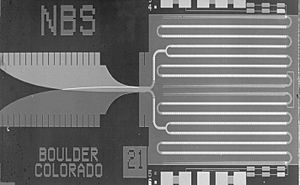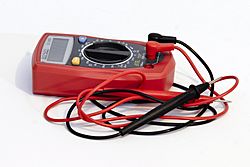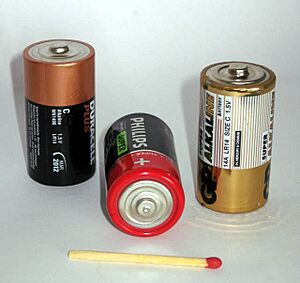Volt facts for kids
For the electric car, see Chevrolet Volt. For the record company, see Volt Records.
The volt (symbol: V) is the special unit used in the SI (the world's main system of measurement) to measure voltage. Voltage is also known as electric potential difference or electromotive force. This unit is named after Alessandro Volta (1745–1827), an Italian physicist. He invented the voltaic pile, which was the very first chemical battery.
Contents
What is a Volt?
A volt measures the "push" or "pressure" of electricity. Imagine it like this:
- One volt is the electric push across a wire.
- This happens when an electric current of one ampere uses up one watt of power.
In simpler terms, a volt tells you how much energy is available to move electric charge. It's like how much "oomph" the electricity has!
Here's how scientists write it using other units:  This means one volt is also equal to one joule of energy per coulomb of charge.
This means one volt is also equal to one joule of energy per coulomb of charge.
How Voltage Works: The Water Analogy
To understand voltage better, think about water flowing through pipes. This is called the hydraulic analogy:
- Voltage is like the water pressure in the pipes. Higher pressure means the water flows faster. In electricity, higher voltage means electrons move faster.
- Current (measured in amperes) is like the amount of water flowing past a point in the pipe.
- Power (measured in watts) is like the total work the water can do, like turning a water wheel.
The simple rule that connects them is: volts × amperes = watts
Everyday Voltages You Might See
Here are some common voltages you might find:
- Nerve cells: Around 0.03 volts (30 millivolts). This is how your body sends signals!
- Rechargeable batteries (NiMH or NiCd): 1.2 volts per cell.
- Alkaline batteries (like AAA, AA, C, D): 1.5 volts per cell. These are the ones you often use in toys and remotes.
- Lithium polymer rechargeable batteries: 3.75 volts. Found in many phones and laptops.
- Small electronic circuits (TTL): 5 volts.
- PP3 battery (the rectangular one): 9 volts.
- Car electrical system: 12 volts.
- Household electricity:
* 230 volts in Europe, Australia, Asia, and Africa. * 120 volts in North America. * 100 volts in Japan.
- Subway or train third rail: 600 to 700 volts.
- High-speed train power lines: 25,000 volts (25 kilovolts).
- Big power lines (transmission lines): 110,000 volts and much higher! The record is 1,150,000 volts.
- Lightning: Can be around 100,000,000 volts (100 megavolts)!
When you see "RMS" (root mean square) for AC power, it means the average effective voltage. The highest point of the voltage in an AC signal is actually higher than the RMS value.
The History of the Volt
The story of the volt began in 1800 with Alessandro Volta. He had a disagreement with another scientist, Luigi Galvani, about how electricity worked. To prove his point, Volta created something amazing: the Voltaic pile.
This "pile" was the first battery ever made! It produced a steady flow of electricity. Volta found that using zinc and silver metals together worked best to make electricity.
Later, in the 1880s, a group called the International Electrical Congress (now the International Electrotechnical Commission) officially named the unit of electromotive force the "volt." They defined it based on how much power (watts) an ampere of current would use.
Related Topics
- SI (for unit prefixes like kilo- or milli-)
- SI electromagnetism units
- Voltmeter (a tool to measure volts)
- Watt (unit of power)
- Ampere (unit of electric current)
Images for kids
-
A group photo of Hermann von Helmholtz and his friends during an important electrical meeting.
See also
 In Spanish: Voltio para niños
In Spanish: Voltio para niños






